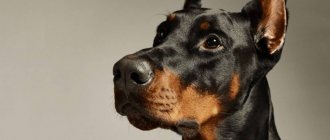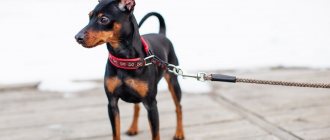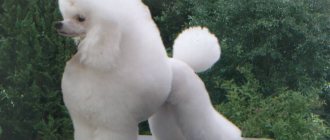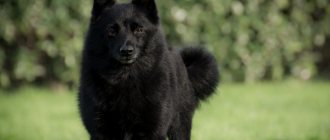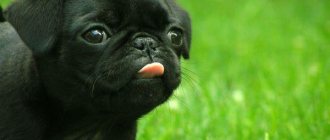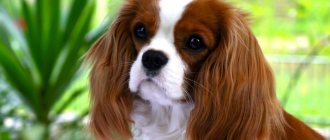Miniature pinschers, or miniature pinschers as these dogs are also called, can give the wrong impression about themselves at the first meeting. So, these dogs may seem shy and timid, but this is not true. In a small body hides a brave heart and character that even the largest and strongest Alabai will envy. Miniature pinschers with red fur look especially interesting and distinctive.
History of the breed
The breed appeared in the 15th century in Württemberg. The dog's ancestors were smooth-haired German pinschers. Italian greyhounds and dachshunds were involved in the formation of the breed .
The head of the first representatives was somewhat shorter and the forehead was wider. Most of them were black and tan.
The miniature pinscher was specially bred to protect the property of grooms and catch rats in the stables. They even began to call him the “thunderstorm of the stables” due to his dexterity and skill in catching rats.
They were also used to escort stagecoaches. They ran like horses, covering long distances.
This dog turned out to be universal, which made him one of the most preferred pets.
In the second half of the 19th century, the breed began to be improved, trying to highlight its best properties. The first standard was established in 1880.
Just 15 years later, the first miniature pinscher fan club appeared in Germany. Then the miniature pinscher went to his first exhibition.
At the beginning of the 20th century, the dog became popular in America. This is one of those German breeds that has gained a lot of interest in America.
And after World War II, the dog began to be bred in France. Today the miniature pinscher is widespread in European countries.
His exhibitions are held annually, where you can see all his breed characteristics.
In Russia, interest in the breed appeared only in the 90s of the last century, when a new generation of dogs was imported from Israel
Breed standard: main characteristics, photographs
Currently, the characteristics of the miniature pinscher are prescribed by the FCI classification. Along with miniature schnauzers, these dogs are among the smallest service dogs. The breed is recommended for freestyle, IPO, agility and other types of sports training.
The miniature pinscher standard indicates a height of 25 to 30 cm. Representatives from 30 to 40 cm are considered medium, not dwarf. The weight of an adult can vary from 4 to 6 kg depending on gender and physical development.
The miniature pinscher is distinguished by a slender, stately figure, strong bones and pronounced muscles:
- The body is taut, elongated, with shiny smooth hair, embossed.
- The paws are thin but powerful. The hind ones are slightly longer than the front ones.
- The head is proportional to the body. The muzzle is elongated with a noticeable transition from the forehead to the nose. The nose is black. The eyes are brown or black, with a clear oval shape. Jaws with a scissor bite, powerful chewers.
- The neck is moderately long, graceful, but strong.
- Ears are set high and protruding.
- The tail is without kinks, saber-shaped or sickle-shaped. Highly placed.
Coat type and color
The color of the miniature pinscher is indicated by the standard in two variants.
- Single-color - traditional brown in shades of different saturations (from brown-red to yellow-mustard).
- Bi-color - black and tan with marked borders above the eyes, along the throat, inside of the hind legs and base of the tail. There are 2 triangles on the chest.
There are two colors of miniature pinschers: black and tan and different shades of brown.
Previously, a brown and tan color was also distinguished, but it was removed from the standard due to its rarity. Now such pinschers are bred only in the USA. The best show coat is brick brown.
Ear cropping
Many consider ear cropping for miniature pinschers to be standard. However, this opinion is wrong. Dogs with cropped or uncropped ears are suitable for exhibitions. Since the breed is not a fighting breed, surgery is not considered necessary.
If the owner decides to correct the appearance of the pet, this must be done until the teeth are replaced (up to 3-4 months). Most often, the shape of standing candles is chosen, but hanging V-shaped options are possible, when only the rounded edges are cut off.
Tail docking occurs in a similar way, leaving 2-3 vertebrae. It should be carried out at 1 week of life. The miniature pinscher endures surgical intervention. Wounds heal quickly with proper treatment and massage.
Psychology
The miniature pinscher has a strong nervous system and a playful and cheerful disposition. He is unshakable and confident. Therefore, the dog needs sensitivity and consistent training.
Among the main qualities are the following:
- Intelligence;
- Mobility;
- Strong teeth and good grip;
- Loud bark that scares away intruders;
- Attachment to the owner;
- Imperious character.
This active and quick-witted dog is always ready to stand up for his owner. His loud bark gives the impression that there is a whole pack of dogs in the house.
This becomes the best way to deter intruders.
The Miniature Pinscher is good with children as long as they understand that the dog is not a toy. Children need to be explained that a pet needs personal space.
He can play with other dogs or run quietly in the park. But towards other dogs, the Miniature Pinscher can be aggressive.
To prevent this from happening, the dog must be trained from an early age.
The pet can play with other dogs or run quietly in the park
Character, behavioral characteristics
The character of the Miniature Pinscher is strong and independent. They are stubborn and willful, nevertheless, they are very devoted to their owner and suffer from lack of attention. However, they do not like excessive tenderness or stroking, and can sometimes behave a little aggressively.
They are very confident in themselves and have a strong psyche. These dogs are active, energetic, and mobile. They get along well with children, play with pleasure, but cannot stand importunity or disrespectful attitude.
Learning ability
Miniature pinschers are distinguished by high intelligence and attentiveness. They are very inquisitive, understanding, and learn many commands after 2-3 repetitions. A Pinscher needs to be trained from puppyhood, otherwise the older dog will no longer obey.
Attitude towards strangers
They treat strangers with caution, mistrust, and greet them with angry barking. The miniature pinscher can attack an attacker when he tries to harm the owner, and will give a worthy rebuff, thanks to lightning-fast reactions and a death grip.
Attitude towards pets
Pinschers often show aggression towards relatives and other animals and tend to dominate. This also applies to unfamiliar dogs on the street. The dog is cocky and often gets into fights even with those who are larger and stronger. They will be able to make friends only with those pets with whom they have lived since puppyhood; They won’t get along with newcomers.
Application
With proper training, the Miniature Pinscher will be an excellent watchdog and companion. He will be the best pet for active and energetic people.
This article will tell you about other companion dogs.
The miniature pinscher's attachment to his owner is so strong that he will protect him even at the risk of his own life.
To impress the enemy, the pet stands on a hill and begins to bark loudly. Most photos show what characteristic pose the dog chooses at this moment.
The miniature pinscher can accompany its owner on trips, as evidenced by reviews from the owners. This breed gets along well in both urban and rural environments.
And in rural areas, its quality in catching rats is especially valuable. As a result, its price is completely justified.
What to feed your dog: creating a diet
Nutrition is an important part of the life of any dog, so the miniature pinscher’s diet must be prepared correctly.
Here are the main components of the pinscher menu:
- 40% of the daily intake should be protein - beef or horse meat (poultry is given only to puppies) raw or boiled;
- 30% comes from porridge - oatmeal or buckwheat (in the absence of allergies, millet is sometimes acceptable);
- A third of the volume of each serving consists of stewed or boiled vegetables with a few drops of sour cream or vegetable oil - beets, carrots, zucchini, pumpkin, broccoli.
Food is provided at a strictly defined time. Water is always freely available. Cottage cheese is added to puppies.
The basis of the miniature pinscher's natural diet is meat, sometimes it is replaced with offal.
When choosing dry food, you should only choose super premium brands that do not contain unnecessary impurities. Varieties are chosen specifically for small breeds. The most suitable dry foods are Now fresh, Orijen, Brit Care, Flatazor, Optima Nova.
How to choose a dog
When choosing a puppy, keep in mind that the breed standard requires only an undocked tail. It should be a natural saber or crescent shape.
But in our country there are both docked and undocked variants. The choice is always up to the breeder, but many now prefer an undocked tail.
When choosing a puppy, you need to focus on the following features:
- See how the puppies behave. They must be active and curious.
- The female should be well-fed, contented and well-groomed. In this case, she will have the same puppies.
- Pay attention to the health of your teeth and bite;
- Eyes, fur and mucous membranes must remain clean;
- The coat should be shiny and smooth, without bald spots.
Don't worry if the puppies are scratched. They often scratch each other when playing
Puppies survive transportation best when they are 2-3 months old. Therefore, it is worth buying them during this period. The price for them is 10-30 thousand rubles. It is determined according to a number of factors:
- The presence of a pedigree, which is why the price rises;
- Parents;
- The presence of breeding marriage, which causes the price to go down;
- Prospects for participation in exhibitions.
Puppies are more expensive if the parents are titled. If there is no pedigree, the purchase will cost less than 10 thousand.
If you buy an animal from a nursery, the cost will be 10-20 thousand rubles. And puppies with great prospects in future exhibitions will cost 30 thousand rubles.
It is better if the puppy's tail is undocked
Care and maintenance
Mini pinschers are not suitable for living outdoors. Their place is in a house or apartment. These dogs do not require much space, and they come up with their own entertainment. At the same time, we must not forget about the activity this breed requires.
Wool
Periodic molting of miniature pinschers will not cause any trouble to the owner. A short coat with no undercoat is not something to worry about. Once a week, the miniature pinscher should be brushed with a soft brush for dogs with smooth hair, and washing should be replaced by wiping with a damp cloth.
Water treatments are only necessary if the little Doberman gets very dirty during a walk.
Walk
Walking a mini pinscher on the property is a pleasure if the fence does not allow him to escape into the street. The dog will arrange games and entertainment for himself. When kept in an apartment, there should be at least three walks per day. At the same time, it is necessary to give your pet time for an independent walk, without a leash, so that he splashes out his energy.
The active little pinscher is not afraid of frost: he warms up by moving. But precipitation is contraindicated for a dog - its smooth fur gets wet, and this can lead to a cold or more serious illnesses. If you encounter bad weather outside, it is better to pick up the miniature pinscher, cover it and take it home.
A good way out of the situation is waterproof overalls that protect the mini Doberman from the vicissitudes of the weather.
Ears
The breed standard does not stipulate mandatory ear cropping for miniature pinschers. But the ears must stand up. Staging is done differently for dogs with cropped and undocked ears.
- Uncropped ears are prone to kinking or being set too high. Tape or glue comes to the rescue, with which the ears are fixed in the required position.
- To install cropped ears, they use a frame - cotton swabs, tape and a degreasing solution.
Mating
Miniature pinschers have virtually no problems when mating: these dogs are healthy and active. Finding a pair is also not a problem – there are quite a lot of representatives of this breed. But certain conditions must also be met.
- It is not advisable to breed a female dog during her first heat. Experts recommend mating no earlier than the third heat. Early mating has a negative impact on the health of the mother and the quality of the offspring.
- Males are allowed to breed no earlier than they are two years old.
Before mating, both the adult male and the female must be treated for parasites, given an anthelmintic, and examined by a veterinarian.
The owners may need help during the process. This is especially true if the male is much larger than the female. In this case, the bitch is held by the neck and the body is raised, and the male is held by the lower back and the process is controlled.
At the beginning of pregnancy, the miniature pinscher bitch loses her appetite and feels weak. But after a few weeks, your appetite will return to normal and even more. In the second half of pregnancy, you need to eliminate unnecessary activity, focusing on long, quiet walks.
Features of feeding and diet
During puppyhood, it is better to feed the miniature pinscher with natural products: raw lean meat, cottage cheese, boiled vegetables, cereals.
An older dog can be switched to dry food. To choose the best option, you should consult your veterinarian. Experts recommend choosing food that is no lower than premium.
The miniature pinscher's feeding time should be constant. It is recommended to feed your dog twice a day. And an active miniature pinscher should have constant access to fresh water.
Usually, miniature pinschers eat little, but with the onset of cold weather, their appetite increases sharply. Indulging your pet's desires can lead to the dog gaining excess weight, which will negatively affect its health. It is better to leave meals and portion sizes the same, but add more protein to the menu.
Combing
This breed is interesting because its coat is easy to care for. Reviews from owners speak about this as well. It is enough to brush the dog several times a week.
Sometimes you can use a damp towel to remove any remaining fur.
Today, such dogs almost always have an undocked tail, although previously the situation was the opposite. But it does not require additional care.
The dog practically does not shed and has no specific odor. Periodic combing is necessary to prevent tangles from appearing. Trimming is carried out twice a year, which allows you to remove old hair.
Grooming the furminator is not used during molting .
The dog practically does not shed and has no specific odor.
Keeping a Miniature Pinscher at Home
The dog is not large in size, so there are not many problems with its maintenance. This breed is quite clean, and grooming is literally elementary. Despite this, each breed has some nuances, so miniature pinschers are not exceptional animals and have their own rules. If you follow these rules, you can ensure a comfortable, problem-free life not only for your pet, but also for yourself.
Care and hygiene
Miniature Pinschers are a short-haired dog breed, so their coat does not need frequent brushing. Even during the shedding period, the dog causes minimal discomfort. Therefore, it is enough to comb the coat once a week using a coarse brush.
In order to prevent ear cleaning, it is necessary to carry out the ear cropping procedure in a timely manner. In this case, you will have to do exclusively preventive examinations.
If you do not do timely and correct docking, you will have to not only frequently examine the animal’s ears, but also clean them regularly. The same can be said for those animals that have floppy ears.
Important point! Experts recommend not bathing this breed, but simply wiping it with a wet towel. This is quite enough, but bathing can lead to disturbances in the microflora of the dog’s coat.
It is equally important to constantly monitor the dog’s oral cavity, especially its teeth. The appearance of tartar leads to serious problems in the oral cavity, requiring qualified intervention. Therefore, the best option is to brush your animal’s teeth at least once a week.
What to feed your miniature pinscher
This breed of dog, like most others, if not all, does not require any special diet, with foods not available. Miniature Pinschers eat what almost all dogs eat, but in much smaller quantities.
For example:
- Almost 30 percent of the diet should consist of meat. As a rule, lean beef, rabbit and poultry are more suitable.
- Almost 25 percent of the diet should consist of items of plant origin. As a rule, vegetables such as carrots, zucchini, beets, cabbage, with the addition of a small amount of vegetable oil, are more suitable. Moreover, you can give both raw and boiled plant products.
- About 30 percent are various cereals. Oatmeal, rice, and buckwheat porridge are more suitable.
About 2 times a week, the menu should include low-fat varieties of sea fish and always without bones.
Interesting moment! A reasonable amount of food is the basis for the health and longevity of a pet. Calculations are made so that for every kilogram of animal weight there is up to 25 grams of feed.
The most suitable option is to use ready-made dry food of high quality. For feeding your miniature pinscher, store-bought food is the most preferable, regardless of the age of the animal.
Dry food, despite its high cost, has a number of advantages. Firstly, they are convenient to store for a long time, and secondly, such food is well balanced in nutrients and can be taken on the road. In any case, you must remember that mixing dry and natural food is not advisable.
Diseases and breed defects
This breed is not ideal, so we can safely talk about flaws in the breed that lead to the disqualification of the pet. For example:
- If the animal has too rough and too light bones.
- Legs short or high.
- The skull is heavy and has a rounded shape.
- You can see folds on the forehead.
- The muzzle is short, pointed or too narrow.
- No scissor bite.
- The eyes are either small or too large, of a light shade.
- Ears are too long or low set.
- If the animal has different types of ears.
- The dewlap stands out noticeably.
- The back is too long, hunchbacked or too soft.
- The croup is sloping.
- Suboptimal gait pattern of the animal.
- The coat is too sparse.
The animal's character must also be within certain limits: the dog should not be cowardly or too aggressive, angry and unbalanced. Miniature Pinschers suffer from a number of different ailments related to the characteristics of the breed. For example:
- Manifestation of urolithiasis.
- Tracheal collapse.
- Diabetes mellitus is possible.
- Shoulder dislocations.
- Manifestation of Legg-Calvé-Perthes disease.
- Pannus.
- Progressive defect of the retina.
- Improper development of the eye corneas.
- Turn of the century.
- They suffer from glaucoma and cataracts.
- Epileptic seizures may occur.
- Congenital deafness is possible.
Quite often, miniature pinschers develop polytraumas as a result of falling from a great height. Moreover, these animals are afraid of cold and drafts. Your pet should be seen regularly by a veterinarian to monitor its health. Vaccinations are mandatory and timely. It is not recommended to ignore the requirements of mandatory and long walks, which are the key to the healthy well-being of the animal.
Dog breed - Miniature Pinscher
Walk
After vaccinations and a quarantine period, the puppy can be walked. The walk should be like this:
- The duration of the first walk should not exceed an hour;
- The pet can run around on a long leash in a public garden or park;
- If after walking the puppy sleeps and lies for a long time, leave the duration of the walk the same;
- If the miniature pinscher remains active after a walk, its duration or intensity increases.
During the walk, the puppies should get tired so that they don’t start causing mischief at home out of boredom. In the first weeks, the breed needs walks at least 5-6 times a day.
Please note that the puppy is growing quickly. To prevent him from becoming stubborn and uncontrollable, it is important to devote time to training.
If you lack experience and have opportunities for frequent training, you can contact a dog trainer.
You can also walk your pet on a leash using a harness for small dog breeds.
This article will tell you more about what is better for a dog: a collar or a harness.
Training begins at 4 months. To do this, it is advisable to go to the site. But take into account the increased activity of the pet and its temperament.
Before the lesson, the dog is given a good walk to tire it out a little. When the commands are worked out correctly, give a special treat or a piece of cheese.
The dog should be scolded for disobedience. Do not allow yourself to be bitten, or try to jump on the sofa or in your arms without permission. Any aggression towards the owners must be quickly extinguished.
A trained and well-mannered miniature pinscher is a wonderful and intelligent dog.
Character and habits of miniature pinschers
Miniature pinschers are dogs that active people should choose. This breed feels comfortable on runs, during any sports activities and during long walks in the fresh air. Miniature Pinschers are incredibly energetic and constantly require the implementation of this energy.
Also, these dogs are distinguished by fearlessness and courage, which sometimes becomes a significant disadvantage of the breed. These are the very small dogs that, if lacking training, are ready to fight with large breeds of dogs such as pit bulls, rottweilers and shepherds. Smart miniature pinschers need proper education and strict training. Otherwise, the dog turns into a manipulator who understands human emotions well.
An untrained miniature pinscher always strives to dominate a person. They can do this through aggression or through pressure on pity. By raising a puppy from the first days of life, the owners get an incredibly smart, energetic and loyal dog. Miniature pinschers will protect the family, especially children, with whom they love to play.
Miniature Pinschers are suspicious of strangers. A guest in the apartment will always remain within the dog's field of vision, and the miniature pinscher will always be ready to drive away the stranger. A well-mannered dog, of course, will not do anything without the owner’s command.
These dogs do not get along with other animals in the house. They especially often conflict with dogs, because they always strive to establish their dominance over them.
Nutrition
Health directly depends on nutrition and the amount of food consumed. A healthy dog will eat whatever is offered to him.
Try not to overfeed him. The photo shows how good healthy dogs look.
If you prefer food , it must be of high quality. It is advisable to use special feed. Look at the description on the packaging.
If you prefer to give your animal natural nutrition, it should be balanced. It is important that the diet is rich in useful elements and substances: protein and calcium.
Education and training
When training and raising a miniature pinscher, patience is required. The cunning pet quickly notices the owner’s weaknesses and skillfully plays on them. Don't allow yourself any slack. If there is a ban on sleeping in the master's bed, then it cannot be violated from the very beginning. Otherwise, you will have to frantically figure out how to wean an adult pet from jumping on sofas and beds.
More detailed education begins at 3-4 months. The high intelligence inherent in the breed contributes to the successful performance of exercises even at such a young age. Show authority to gain your dog's respect. More complete information about the nuances of training can be obtained from a dog handler.
The kennel club tells in detail how to raise an obedient pet with a stable psyche. The best reviews are received by joint classes with a pet on an individual basis, where all attention is focused on the formation of an unbreakable bond between man and dog.
Never use force during training. Cruelty to animals undermines trust, fostering cowardice and aggression. Destructive behavior risks taking out anger on other animals, strangers, and even family members.
With little experience with dogs, it is not entirely clear how to train a pet to use a litter box. Owners are not always ready to go outside in winter, so miniature dogs can be taught to go to the toilet at home. Once accustomed to the diaper, place it in the tray, showing the puppy a new place to relieve itself. Wait until your pet starts to worry and put him in the tray. After a successful operation, be sure to praise the puppy and reward him with a treat.
Sometimes several training sessions are required. The main thing here is not to scold your pet when it makes a mistake. Frightened, the puppy will receive a persistent negative reaction and will avoid the tray with all possible forces.
The first walks on the street begin after six months, when the puppy has received all the necessary vaccinations. It is very easy to toilet train outdoors, as the miniature pinscher quickly adopts the habits of other animals.
A trained pet must know the basic commands from the OKD and UGS course. If you want to master more difficult disciplines, but doubt whether it is possible to train a dog in agility, feel free to start your first lessons. In sports disciplines, miniature pinschers demonstrate amazing speed and agility in overcoming the highest objects.
Health
Miniature Pinschers have short fur, which provides poor protection from the cold. But the breed tolerates light frosts tolerably.
And in severe cold weather, you should limit your walking time. You can get out of this situation by buying warm overalls and special boots for your pet.
Due to its short fur, the miniature pinscher is not adapted to frost; for these purposes, it needs to buy special “clothes”
Breeding miniature pinschers
Breeding miniature pinschers is regulated by dog breeding rules in each specific country. In Russia, for example, there is a Breeding Regulation that allows the first time to breed a miniature pinscher bitch no earlier than 15 months old and provided that the dog has gone through one heat. You can breed a dog once a year, and use the bitch for breeding until she is eight years old.
Professional breeders who care about the health of dogs breed a bitch only after the third heat and only when the dog is at least one and a half years old. Also, frequent childbirth exhausts the dog, which also harms its health, and, consequently, the health of the offspring.
During the period of heat, bitches are put on diapers, since these restless dogs take extremely poor care of themselves due to the constant desire to move.
Miniature pinschers should only be bred within the breed. Mating outside the breed is fraught with genetic incurable diseases in the offspring, and such outbred offspring are more difficult to sell - there will simply be no documents for them.
Miniature pinschers, due to their good health, tolerate pregnancy well, and childbirth proceeds without problems. In the first three to four weeks, the bitch may be lethargic; she will not want to run and walk as much. There is no need to change the diet, but it is still worth taking him for walks - the dog needs physical activity.
Towards the end of the pregnancy period, the bitch begins to have problems with appetite, and you should not force feed the dog. When the time approaches for giving birth, the dog will still begin to eat a lot and gain strength. Breeders recommend not increasing portions, but only adding one additional stage of feeding. This way the dog will not gain excess weight. Childbirth proceeds calmly, but it is worth having the veterinarian’s phone number at hand.
Vaccinations
Before vaccination , it is necessary to get rid of worms. Special tablets are used for this purpose. As a rule, they are given by weight.
You can also use the drug, which comes in the form of sugar. Most dogs accept it with great pleasure. Such drugs can be purchased at veterinary pharmacies or pet stores.
The puppy must be healthy before vaccination. As a rule, the first vaccination is done by the breeder or it is carried out in the nursery.
There should be a corresponding note about this in the veterinary passport. After 3 weeks, a second vaccination is given. After 10 days you can go for a walk with the puppy.
As a rule, many people stop there. But you can have another vaccination 6-7 months after changing teeth. This is necessary, since during this period the dog’s immunity decreases.
For two days after vaccination, the pet may be lethargic. But it will pass quickly. The next vaccination is carried out at 1.5 years, and then every year.
You should only buy a puppy if you have a veterinary passport.
Diseases and health problems
Miniature pinschers are in good health, so they have almost no diseases. Their most vulnerable spot is their eyes, so any health problems are most often associated with them.
For example, a turn of the century. This pathology can occur if the dog's eye has been injured, but is sometimes a congenital disease. The eyeball turns red and watery, the dog feels pain and inflammatory processes begin. Diagnosed only by veterinarians and treated with surgery.
Glaucoma also occurs in miniature pinschers. It is associated with increased intraocular pressure, which significantly reduces visual acuity. It is a rare congenital disease and requires systematic, consistent treatment throughout life. It can be noticed by the many inflamed capillaries in the eye.
Cataracts can be noticed when a dog's eye lens becomes cloudy. Because of this, the animal loses its vision and, without treatment, can become completely blind. The eye becomes cloudy or blue-gray. It occurs more often in older dogs, and in young dogs it can appear due to heredity and illiterate selection. Also, cataracts are often accompanied by problems with the endocrine system and decreased immunity.
Pannus is a disease of the autoimmune system, due to which the membrane of the eye is covered with a dense cornea. It cannot be treated, you can only slow down its development.
All diseases are predicted by proper care and proper breeding. Professional breeders do not allow the occurrence of any hereditary diseases.
